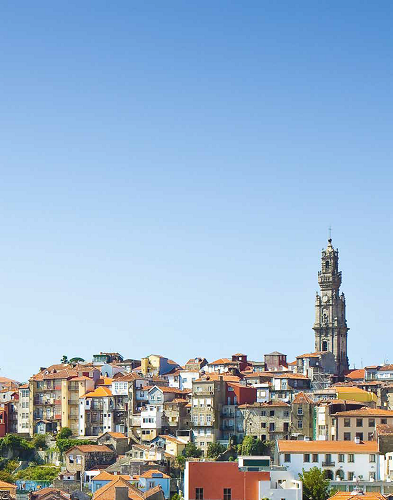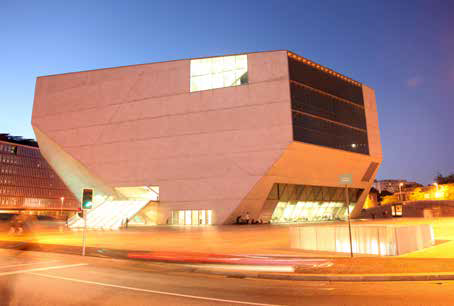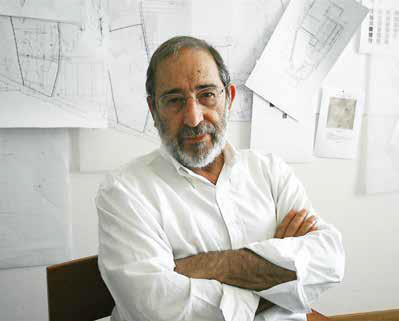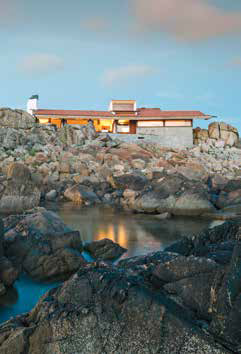
The city of Porto, the birthplace of MDS
Porto has never faltered in stressing its main vocation as a merchant centre and port (as perpetuated in its name). First established in the Bronze Age, over 2,500 years ago, on a strategic hill above the estuary of one of the greatest rivers of the Iberian Peninsula, the city grew considerably during the Roman period (when it was first named "portus”).
By the end of the Middle Ages, Porto had experienced new and important urban developments responding to the increasingly dynamic and pioneering spirit of its merchants – which would lead to the maritime expansion that the Portuguese would be recognised for from the 15th century on.
The people’s entrepreneurial and nonconformist characteristics, forever marking the spirit and identity of the city, were fundamental by the 19th century for the establishment of liberalism, for a new industrial period and, later, for the triumph of the republican regime. The old Penaventosa hill, crowned by the medieval cathedral, has witnessed all this development and, since 1996, has been a UNESCO World Heritage site.
By the end of the Middle Ages, Porto had experienced new and important urban developments responding to the increasingly dynamic and pioneering spirit of its merchants – which would lead to the maritime expansion that the Portuguese would be recognised for from the 15th century on.
The people’s entrepreneurial and nonconformist characteristics, forever marking the spirit and identity of the city, were fundamental by the 19th century for the establishment of liberalism, for a new industrial period and, later, for the triumph of the republican regime. The old Penaventosa hill, crowned by the medieval cathedral, has witnessed all this development and, since 1996, has been a UNESCO World Heritage site.
Eugénio de Andrade
One of the most important names in 20th century Portuguese culture, while not born in Porto, is irrefutably, its greatest poet, Eugénio de Andrade (1923‑2005) came to live in the city in 1950 and immediately fell in love with it and would spend the rest of his life in, what he described as "the little town square where, for so many years, I have been methodically learning to be a tree”.
The poet would dedicate many of the pages and verses that he wrote to the scenarios and landscapes of the borough, to Porto’s people, its identity and to the friends he made there. He also bequeathed the city one of the most beautiful books about Porto, the "Daqui houve nome Portugal”.
The poet would dedicate many of the pages and verses that he wrote to the scenarios and landscapes of the borough, to Porto’s people, its identity and to the friends he made there. He also bequeathed the city one of the most beautiful books about Porto, the "Daqui houve nome Portugal”.
Casa da Música

One of Porto’s most iconic elements is its trams which have been rolling through the city since 1895. For decades, the main tram shed and workshop for the public system was located in the Boavista roundabout.
The site was redeveloped at the beginning of the 21st century and in its place is one of the most emblematic buildings in Porto, the Casa da Música (literally The House of Music). Inaugurated in 2005 with a concert by Lou Reed, the structure was conceived by Dutch architect Rem Koolhaas and its construction presented many new engineering challenges. The New York Times described the Casa da Música as "one of the most important show theaters built over the last 100 years”. Coincidentally, José Manuel Fonseca, MDS’s Group Chief Executive, was President of Casa da Música from its foundation until 2014.
The site was redeveloped at the beginning of the 21st century and in its place is one of the most emblematic buildings in Porto, the Casa da Música (literally The House of Music). Inaugurated in 2005 with a concert by Lou Reed, the structure was conceived by Dutch architect Rem Koolhaas and its construction presented many new engineering challenges. The New York Times described the Casa da Música as "one of the most important show theaters built over the last 100 years”. Coincidentally, José Manuel Fonseca, MDS’s Group Chief Executive, was President of Casa da Música from its foundation until 2014.
Image: Casa da Música, ©Matilde Ramos
Belmiro de Azevedo
Belmiro de Azevedo
Born in Marco de Canaveses near Porto, in 1938, Belmiro de Azevedo is one of Portugal’s most successful businessmen. A chemical engineering graduate, he assumed control of Sonae in 1974 and the year after, specialised in business management at Harvard University.
His rare entrepreneurial capacities, his pioneering vision and the culture he implemented at Sonae, transformed the group, growing from its Porto base into one of the most dynamic companies internationally. Sonae is a multinational company managing a diversified portfolio of businesses in retail, financial services, technology, shopping centres and telecommunications.
He is one of the most respected people in Portugal, recognised for his boldness and spirit, non‑conformity and relentless defense of his values, strongly represented in the group he created. He was also linked to several international organisations and received praise for his work in several countries, such as Spain and Brazil.
His rare entrepreneurial capacities, his pioneering vision and the culture he implemented at Sonae, transformed the group, growing from its Porto base into one of the most dynamic companies internationally. Sonae is a multinational company managing a diversified portfolio of businesses in retail, financial services, technology, shopping centres and telecommunications.
He is one of the most respected people in Portugal, recognised for his boldness and spirit, non‑conformity and relentless defense of his values, strongly represented in the group he created. He was also linked to several international organisations and received praise for his work in several countries, such as Spain and Brazil.

Ângelo Paupério, Paulo Azevedo and Belmiro de Azevedo. ©Pedro Granadeiro
Manoel de Oliveira
When Manoel de Oliveira passed away in 2015 at 106 years of age, the country took the news with difficulty. The filmmaker and director who was born in Porto in 1908, had come to be viewed as an immortal figure by the Portuguese. He remains the oldest director in history, with the longest career in cinema.
He started out as an extra at Invicta Film, a pioneer of Portuguese silent movies. His first movie – "Douro Faina Fluvial” (1931) – was a silent film but he then lived through the history of 20th century of analogue cinema, directing essential works such as "Aniki‑Bobo” (1942), "Amor de Perdição” (1979), "Francisca” (1981) and "Vale Abraão” (1993). He directed 32 feature films, his last one was in 2014. Awarded the Golden Lion of the Venice Film Festival, Manoel de Oliveira directed internationally renowned actors such as Marcelo Mastroianni, John Malkovich or Catherine Deneuve.
He started out as an extra at Invicta Film, a pioneer of Portuguese silent movies. His first movie – "Douro Faina Fluvial” (1931) – was a silent film but he then lived through the history of 20th century of analogue cinema, directing essential works such as "Aniki‑Bobo” (1942), "Amor de Perdição” (1979), "Francisca” (1981) and "Vale Abraão” (1993). He directed 32 feature films, his last one was in 2014. Awarded the Golden Lion of the Venice Film Festival, Manoel de Oliveira directed internationally renowned actors such as Marcelo Mastroianni, John Malkovich or Catherine Deneuve.
Álvaro Siza
 In 2005, Álvaro Siza, one of the most highly regarded architects of his generation, was awarded the keys to the city of Porto. Born in 1933, in the neighbouring coastal town of Matosinhos, Siza credits the area’s linear and artless maritime landscape as the spirit of his creativity, although, he doesn’t deny the influences of other architectural greats such as Adolf Loos, Alvar Aalto and Frank Lloyd Wright.
In 2005, Álvaro Siza, one of the most highly regarded architects of his generation, was awarded the keys to the city of Porto. Born in 1933, in the neighbouring coastal town of Matosinhos, Siza credits the area’s linear and artless maritime landscape as the spirit of his creativity, although, he doesn’t deny the influences of other architectural greats such as Adolf Loos, Alvar Aalto and Frank Lloyd Wright. In a way, Siza synthesized these 20th century masters with a very personal language and appearance, which, since the 1960s, has firmly evolved into a worldwide reference. This was recognised in 1992 with a Pritzker Architecture prize – considered the Nobel Prize of architecture – and in 2009 when he was presented with the Royal Gold Medal for Architecture by Queen Elizabeth II.
Eduardo Souto Moura
Continuing the architectural theme, another Pritzker prize winner with close links to Porto was honoured in 2011. Eduardo de Souto Moura, born in the city in 1952, became only the second winner to receive their Laureate from a serving US President. Barack Obama described Souto Moura as someone who "is never satisfied with easy solutions”.
The architect of the Municipal Stadium of Braga and Casa da Histórias Paula Rego in Portugal and projects all over the world, Souto Moura was responsible for the rehabilitation of emblematic and historical buildings in Porto such as the Prison of Relação (Cadeia da Relação) and The New Customs building (Alfândega Nova) and the city’s award‑winning subway stations.
The architect of the Municipal Stadium of Braga and Casa da Histórias Paula Rego in Portugal and projects all over the world, Souto Moura was responsible for the rehabilitation of emblematic and historical buildings in Porto such as the Prison of Relação (Cadeia da Relação) and The New Customs building (Alfândega Nova) and the city’s award‑winning subway stations.
Casa de Chá da Boa Nova
 Built between 1958 and 1963 and just two meters above the ocean in one of the rockiest areas of greater Porto’s Atlantic coast, the Casa de Chá da Boa Nova (literally the Tea House of Boa Nova) is an architectural and gastronomic delight.
Built between 1958 and 1963 and just two meters above the ocean in one of the rockiest areas of greater Porto’s Atlantic coast, the Casa de Chá da Boa Nova (literally the Tea House of Boa Nova) is an architectural and gastronomic delight. Architect Álvaro Siza completed the building in 1963 and then over 50 years later, transformed the space into a restaurant for Portuguese chef Rui Paula, who recently (2016) secured a Michelin star.
São João (Saint John's) Festivities
Although "Our Lady of Vandoma” (whose medieval image can be found inside Porto’s cathedral) is the city’s patroness, the most popular saint in Porto is Saint John Baptist.
Celebrated on the 24th of June, his festivities were already deeply embedded in Porto by the 14th century. Fernão Lopes, a chronicler who wrote the history of Portugal, described the pagan roots of these celebrations held in the summer solstice.
Saint John’s festivities bring hundreds of thousands of people on to the streets, mixing traditional gastronomy with music, dancing, campfire jumping, fireworks, processions and "scent exchanges” between people who carry leeks, aromatic herbs and basil flowers. The National Geographic magazine considers this one of the world’s most unmissable events.
Port Wine
 Whilst a secret since the Middle Ages, it took the interest of British merchants in the 17th century, for it to become famous worldwide. Port wine is impossible to copy anywhere else on the planet.
Whilst a secret since the Middle Ages, it took the interest of British merchants in the 17th century, for it to become famous worldwide. Port wine is impossible to copy anywhere else on the planet. Produced over 200 kms away from Porto, in the vineyards of the Douro cliffs – an ancient and regulated demarcated wine region – Port is transported and aged on the estuary of the city’s great river, in the cellars that have turned that area into a UNESCO World Heritage site.
Port is the best of two worlds: a very sweet nectar and, simultaneously, a high alcohol content. It is also the origin of some of the best wine ever: bottles of Taylor and Fonseca vintage from 1994 were awarded a prestigious 100 points from Wine Spectator magazine.
Written by Joel Cleto
Joel Cleto was born in Porto in 1965. With a degree in history and Master of Archeology from the University of Porto, he is a college teacher of Art and Heritage. He is an author and host of the acclaimed TV show "Caminhos da História” which airs on the Porto Canal TV network.



